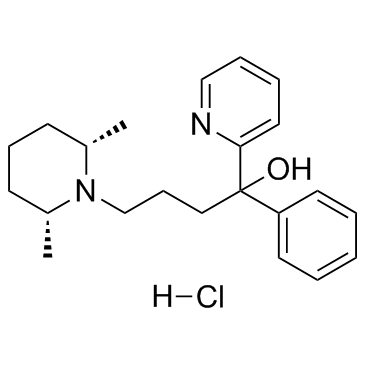61477-94-9
| Name | 4-[(2S,6R)-2,6-dimethylpiperidin-1-yl]-1-phenyl-1-pyridin-2-ylbutan-1-ol,hydrochloride |
|---|---|
| Synonyms |
Pirmenol hydrochloride monohydrate
pirmenol hydrochloride Pirmenol hydrochloride (USAN) Pirmenol HCl CI 845 4-[(2R,6S)-2,6-dimethylpiperidin-1-yl]-1-phenyl-1-pyridin-2-ylbutan-1-ol hydrochloride Pirmenol (hydrochloride) |
| Description | Pirmenol hydrochloride inhibits IK.ACh by blocking muscarinic receptors. The IC50 of Pirmenol for inhibition of Carbachol-induced IK.ACh is 0.1 μM. |
|---|---|
| Related Catalog | |
| Target |
IC50: 0.1 μM (IK.ACh)[1] |
| In Vitro | Pirmenol inhibits the carbachol-induced IK.ACh in a concentration-dependent manner. Pirmenol also inhibits the GTPγS-induced current although the concentrations of Pirmenol needed to inhibit the GTPγS-induced current are much higher than those to inhibit the carbachol-induced IK.ACh. The IC50 of Pirmenol for inhibition of the GTPγS-induced currents is 30 μM. The inhibitory effect of Pirmenol on these IK.ACh is almost completely reversible and the outward current reappeared upon washout of Pirmenol. Pirmenol on the muscarinic acetylcholine receptor-operated K+ current (IK.ACh) in atrial cells and on experimental atrial fibrillation in isolated guinea-pig hearts. In isolated atrial myocytes, Pirmenol concentration dependently inhibits the IK.ACh induced by carbachol or intracellular loading of GTPγS. In Langendorff-perfused hearts Pirmenol reverses the carbachol-induced decreases in effective refractory periods and atrial fibrillation threshold[1]. |
| In Vivo | The pyridine-methanol derivative Pirmenol hydrochloride is a new antiarrhythmic agent. Single-dose studies in rodents demonstrate a 10- to 15-fold difference between the po and iv LD50 values. In rats, the po LD50 is 359.9 mg/kg and the iv LD50 is 23.6 mg/kg. Mice LD50 values are 215.5 and 20.8 mg/kg for po and iv routes, respectively. Short-term subacute iv toxicity studies in rats (2.5, 5.0, and 7.5 mg/kg) and dogs (2.5, 5, and 10 mg/kg) for 4 weeks elicite minimal reactions. Cardiac effects in dogs include drug related increases in heart rate, increases QRS duration, shortening of ST interval without evidence of cardiac tissue damage and mild local reaction at the injection site. Orally, Pirmenol is well tolerated for 13 weeks in rats receiving 25, 50, and 100 mg/kg/day while dogs given 5, 10, and 15 mg/kg/day shows anticholinergic effects at high levels (dryness of mucosae, body tremors). Heart rates are significantly accelerated only at the beginning of the study and QRS changes are seen with wide individual variations. No drug-related tissue changes are elicited in these species. Teratology studies in rats (50, 100, and 150 mg/kg) and in rabbits (10, 25, and 50 mg/kg) show no overt effect on organogenesis but embryotoxicity is seen at 150 mg/kg in rats[2]. |
| Animal Admin | Mice and Rats[2] The species and strains used in these studies are: male mice, 21-29 g; rats, 116-261 g; purebred beagle dogs,6.8-12.4 kg;and rabbits, 2.9 kg average. For acute oral and intravenous studies and subacute oral studies, Pirmenol hydrochloride, hereafter referred to as Pirmenol, is supplied as bulk white crystalline compound of approximately 89% purity. Doses are calculated on the basis of base content. In acute studies, Pirmenol is given by gavage as 2 (mice) or 2.5% (rats) in aqueous solution; for iv administration, as 0.5 (mice) or 1% (rats) aqueous solution. In oral subacute studies in dogs, it is given in gelatin capsules, and in rats, it is mixed with the diet to yield the intended dose concentrations. Rabbits received the drug in a 5% aqueous solution by intragastric intubation. For subacute iv studies, Pirmenol is supplied in sterile vials as a 1% solution. In rats, iv injection approximated 0.6 mL/min, and in dogs, the drug is administered via an infusion pump at the rate of 1 mg/kg/min. |
| References |
| Boiling Point | 499.6ºC at 760 mmHg |
|---|---|
| Molecular Formula | C22H31ClN2O |
| Molecular Weight | 374.94700 |
| Flash Point | 256ºC |
| Exact Mass | 374.21200 |
| PSA | 36.36000 |
| LogP | 5.10050 |
| Storage condition | -20°C |
CHEMICAL IDENTIFICATION
HEALTH HAZARD DATAACUTE TOXICITY DATA
MUTATION DATA
|
